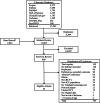Heterogeneity in design and analysis of ICU delirium randomized trials: a systematic review
- PMID: 34016134
- PMCID: PMC8136095
- DOI: 10.1186/s13063-021-05299-1
Heterogeneity in design and analysis of ICU delirium randomized trials: a systematic review
Abstract
Background: There is a growing number of randomized controlled trials (RCTs) evaluating interventions to prevent or treat delirium in the intensive care unit (ICU). Efforts to improve the conduct of delirium RCTs are underway, but none address issues related to statistical analysis. The purpose of this review is to evaluate heterogeneity in the design and analysis of delirium outcomes and advance methodological recommendations for delirium RCTs in the ICU.
Methods: Relevant databases, including PubMed and Embase, were searched with no restrictions on language or publication date; the search was conducted on July 8, 2019. RCTs conducted on adult ICU patients with delirium as the primary outcome were included where trial results were available. Data on frequency and duration of delirium assessments, delirium outcome definitions, and statistical methods were independently extracted in duplicate. The review was registered with PROSPERO (CRD42020141204).
Results: Among 65 eligible RCTs, 44 (68%) targeted the prevention of delirium. The duration of follow-up varied, with 31 (48%) RCTs having ≤7 days of follow-up, and only 24 (37%) conducting delirium assessments after ICU discharge. The incidence of delirium was the most common outcome (50 RCTs, 77%) for which 8 unique statistical methods were applied. The most common method, applied to 51 of 56 (91%) delirium incidence outcomes, was the two-sample test comparing the proportion of patients who ever experienced delirium. In the presence of censoring of patients at ICU discharge or death, this test may be misleading. The impact of censoring was also not considered in most analyses of the duration of delirium, as evaluated in 24 RCTs, with 21 (88%) delirium duration outcomes analyzed using a non-parametric test or two-sample t test. Composite outcomes (e.g., rank-based delirium- and coma-free days), used in 11 (17%) RCTs, seldom explicitly defined how ICU discharge, and death were incorporated into the definition and were analyzed using non-parametric tests (11 of 13 (85%) composite outcomes).
Conclusions: To improve delirium RCTs, outcomes should be explicitly defined. To account for censoring due to ICU discharge or death, survival analysis methods should be considered for delirium incidence and duration outcomes; non-parametric tests are recommended for rank-based delirium composite outcomes.
Trial registration: PROSPERO CRD42020141204 . Registration date: 7/3/2019.
Keywords: Critically ill patients; Delirium; Outcome definition; Randomized trials; Statistical methods; Systematic review.
Conflict of interest statement
KN reports grants from Hitachi, personal fees from Merck & Co, outside the submitted work; and DMN reports grants from NIH, during the conduct of the study; personal fees from Haisco USA, outside the submitted work; the remaining authors declare that they have no competing interests.
Figures

Similar articles
-
Non-pharmacological interventions for sleep promotion in hospitalized children.Cochrane Database Syst Rev. 2022 Jun 15;6(6):CD012908. doi: 10.1002/14651858.CD012908.pub2. Cochrane Database Syst Rev. 2022. PMID: 35703367 Free PMC article.
-
Automated monitoring compared to standard care for the early detection of sepsis in critically ill patients.Cochrane Database Syst Rev. 2018 Jun 25;6(6):CD012404. doi: 10.1002/14651858.CD012404.pub2. Cochrane Database Syst Rev. 2018. PMID: 29938790 Free PMC article.
-
Early intervention (mobilization or active exercise) for critically ill adults in the intensive care unit.Cochrane Database Syst Rev. 2018 Mar 27;3(3):CD010754. doi: 10.1002/14651858.CD010754.pub2. Cochrane Database Syst Rev. 2018. PMID: 29582429 Free PMC article.
-
A rapid and systematic review of the clinical effectiveness and cost-effectiveness of topotecan for ovarian cancer.Health Technol Assess. 2001;5(28):1-110. doi: 10.3310/hta5280. Health Technol Assess. 2001. PMID: 11701100
-
Interventions for interpersonal communication about end of life care between health practitioners and affected people.Cochrane Database Syst Rev. 2022 Jul 8;7(7):CD013116. doi: 10.1002/14651858.CD013116.pub2. Cochrane Database Syst Rev. 2022. PMID: 35802350 Free PMC article.
Cited by
-
Delirium management and current practice among Intensive Care Units Doctors, Khartoum.F1000Res. 2025 Feb 19;13:456. doi: 10.12688/f1000research.142233.4. eCollection 2024. F1000Res. 2025. PMID: 39925989 Free PMC article.
-
Assessment of level of knowledge, attitude, and associated factors toward delirium among health professionals working in intensive care unit multicenter, cross-sectional study, Amhara region comprehensive specialized hospitals, Northwest Ethiopia, 2023.Front Public Health. 2024 Mar 6;12:1338760. doi: 10.3389/fpubh.2024.1338760. eCollection 2024. Front Public Health. 2024. PMID: 38510361 Free PMC article.
-
Prioritizing attributes of approaches to analyzing patient-centered outcomes that are truncated due to death in critical care clinical trials: a Delphi study.Trials. 2025 Jan 10;26(1):15. doi: 10.1186/s13063-024-08673-x. Trials. 2025. PMID: 39794867 Free PMC article.
-
Timing errors and temporal uncertainty in clinical databases-A narrative review.Front Digit Health. 2022 Aug 18;4:932599. doi: 10.3389/fdgth.2022.932599. eCollection 2022. Front Digit Health. 2022. PMID: 36060541 Free PMC article. Review.
-
Heterogeneity in the definition of delirium in ICUs and association with the intervention effect in randomized controlled trials: a meta-epidemiological study.Crit Care. 2023 May 4;27(1):170. doi: 10.1186/s13054-023-04411-y. Crit Care. 2023. PMID: 37143091 Free PMC article.
References
-
- American Psychiatric Association . Diagnostic and statistical manual of mental disorders: DSM-5. Washington DC: American Psychiatric Association; 2013.
Publication types
MeSH terms
Grants and funding
LinkOut - more resources
Full Text Sources
Other Literature Sources
Medical

